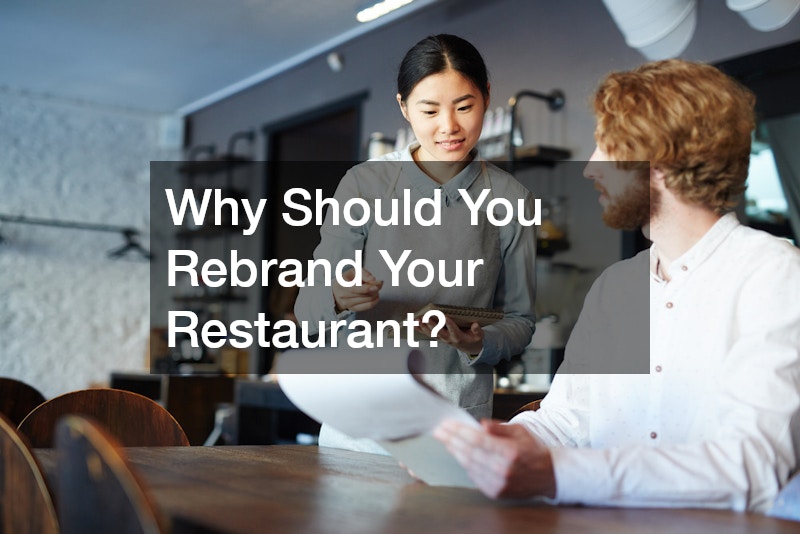
Restaurant rebranding is one of the most powerful tools a business owner can use to stay relevant, grow market share, and create a fresh connection with both loyal customers and new audiences. Whether you’re operating a cozy local restaurant, a high-energy sports bar and grill, a trendy pizza restaurant, or offering specialized catering services, the dining industry is constantly evolving. Customer preferences shift, competition increases, and the pressure to stand out becomes more intense every year. That’s where restaurant rebranding comes into play.
Restaurant Rebranding Is More Than a Makeover
Restaurant rebranding is more than a fresh coat of paint—it’s a powerful opportunity to elevate your business, re-engage your community, and build a brand that grows with you. Whether you’re enhancing your menu, redesigning your space, or expanding catering services, rebranding allows you to stay competitive in a fast-changing industry.
A Strategic Shift Toward Growth
Rebranding your restaurant is more than a cosmetic update—it’s a bold, forward-thinking strategy that reflects your business’s evolution and sets the stage for continued growth. From redefining your visual identity to launching new menu items, updating your digital presence, and enhancing customer experience, restaurant rebranding allows you to reposition your business to better meet the needs of today’s diners.
For All Types of Restaurants and Services
Whether you’re operating a local restaurant, a classic pizza restaurant, a bustling sports bar and grill, or offering niche catering services, restaurant rebranding can bring renewed energy to your business and help you reach new heights. A well-executed rebrand can serve as a powerful tool to stand out in a crowded marketplace, attract new demographics, and build deeper connections with your community.
Adapting to Change for a Stronger Brand
Restaurant rebranding allows you to adapt to changing tastes, explore new opportunities like local catering services or event catering service, and ultimately improve your bottom line. Even something as seemingly simple as refreshing your logo or updating your menu can lead to increased customer interest, better reviews, and stronger brand loyalty.
Think Strategy, Not Just Style
But restaurant rebranding also requires thoughtful planning, clear communication, and a deep understanding of your audience. It’s about crafting a story and experience that reflects your mission, values, and future vision. By engaging your team, listening to your customers, and investing in quality design and execution, you can ensure your restaurant rebranding journey is both impactful and enduring.
Let Your Brand Grow With You
As you move forward, remember that your brand is a living, breathing part of your business. Don’t be afraid to evolve. Whether you’re launching new BBQ grills offerings, promoting your signature hot wings, or entering the weight loss and wellness dining niche, restaurant rebranding should always align with where your business is headed.
Why a Strong Brand Matters Now More Than Ever
In a world where customer expectations are higher than ever and competition is fierce, a strong and relevant brand can be the deciding factor in your restaurant’s success. So take the leap. Reimagine, refine, and reinvent your business through restaurant rebranding—and watch your brand story unfold in exciting new ways.
1. What is Restaurant Rebranding?
1.1 Definition and Importance
Restaurant rebranding is the strategic process of updating or transforming your brand’s identity to better reflect your values, mission, and market position. It includes everything from updating your logo and decor to redefining your menu and customer experience.
1.2 Common Misconceptions
Many believe restaurant rebranding means starting from scratch. In reality, it often involves refining and modernizing your existing brand to better connect with today’s diners.
1.3 Key Components
A successful restaurant rebrand should encompass a cohesive visual identity—including logo, color palette, and typography—alongside a refreshed menu and culinary concept, an optimized digital presence through website, SEO, and social media, updated interior and exterior design, and a clear, consistent marketing and communications strategy
1.4 Rebranding vs. Branding
Branding builds something from the ground up. Restaurant rebranding is about giving your existing identity a strategic refresh.
1.5 Real-Life Examples
From pizza restaurants offering gluten-free options to sports bars introducing health-conscious items, successful rebrands meet modern demands without losing their essence.
2. Why Should You Rebrand Your Restaurant?

2.1 Stay in Tune with Market Trends
Customer tastes evolve. Offering plant-based dishes, incorporating tech tools, or adopting eco-conscious packaging can help your restaurant remain relevant.
2.2 Improve Customer Experience
From a fresh menu layout to an upgraded online ordering system, restaurant rebranding enhances every touchpoint of the customer journey.
2.3 Boost Competitive Advantage
A unique, recognizable brand helps you stand out in a saturated market and builds trust and interest among new diners.
2.4 Refresh Outdated Aesthetics
An old logo or dated interior can send the wrong message. A visual upgrade signals that your restaurant is thriving and invested in quality.
2.5 Reach New Demographics
Want to appeal to millennials, families, or event planners? A rebrand helps you target and connect with new customer segments more effectively.
3. When is the Right Time to Rebrand?
3.1 Signs You Need a Rebrand
Signs that you may need a restaurant rebrand include slowing sales or low customer engagement, outdated design or messaging, new competitors entering your market, and a business pivot—such as expanding your offerings by adding a catering service.
3.2 Timing Considerations
Avoid peak times—opt for quieter seasons or sync your rebrand with a menu launch, business anniversary, or local event.
3.3 Competitor Influence
If nearby restaurants have rebranded and are gaining traction, it may be time to reevaluate your position in the market.
4. How to Develop a Restaurant Rebranding Strategy

4.1 Conduct Market Research
Survey your customers, study your competitors, and gather insights from social media and industry publications.
4.2 Set Clear Goals
Decide what success looks like: More bookings? Better reviews? Expanded reach for your local catering services?
4.3 Craft a Compelling Brand Story
Whether you’re a modern sports bar or a traditional pizza place, a story connects emotionally and makes your brand more memorable.
4.4 Budget Smartly
From web design to signage, budget every step. Consider applying for local business loans to support major changes.
4.5 Engage Your Team
Involve staff in brainstorming, design decisions, and rollout. Their insight and buy-in are crucial to a smooth transition.
5. Key Elements of Restaurant Rebranding
5.1 Visual Identity
Design a logo, font system, and color palette that reflect your updated mission and appeal to your ideal customer.
5.2 Menu Innovation
Introduce trendy yet relevant options like keto meals, hot wings upgrades, or signature BBQ grills specials to excite both new and loyal guests.
5.3 Atmosphere and Decor
Create a memorable dining environment that complements your brand’s personality, from lighting to seating and layout.
5.4 Service Model
Consider whether a new service style—such as counter-service, self-order kiosks, or table side tech—better suits your concept.
5.5 Digital Presence
Update your website, Google listing, and social media with fresh visuals, bios, and menus that align with your rebrand.
6. Executing the Rebrand Successfully

6.1 Create a Timeline
Outline your full rebranding schedule—from design to announcement to launch—and assign roles and responsibilities.
6.2 Train Your Team
Employees should understand the brand shift and be able to speak confidently about it to customers.
6.3 Marketing Integration
Promote your rebrand through a multi-channel campaign. Emphasize new offerings like catering services, menu updates, or events.
6.4 Host a Relaunch
Throw a grand reopening, invite local foodies or influencers, and use limited-time offers to draw in a crowd.
6.5 Gather Feedback
Monitor guest reactions and adjust as needed. Continuous refinement leads to long-term restaurant rebranding success.
7. What Does Restaurant Rebranding Cost?
7.1 Budget Wisely
Depending on scope, costs can vary greatly. Focus spending where ROI is likely to be highest—branding, photography, and digital.
7.2 Optimize Resources
Use local vendors or repurpose existing assets. Bundling services like signage, menus, and content can cut costs.
7.3 In-House vs. Outsourcing
Professionals can bring a cohesive look and avoid expensive missteps.
7.4 Financial Planning
Revisit your business plan, and consider financing or phased rollouts to reduce the pressure on cash flow.
8. Measuring the Impact of Your Rebrand

8.1 Track Your Goals
Set KPIs for traffic, reviews, sales, and social engagement. Use tools like Google Analytics and POS data.
8.2 Customer Feedback
Listen to what your diners are saying—good or bad. Surveys and social media can be powerful feedback loops.
8.3 Sales Growth
Track pre- and post-rebrand performance in catering orders, dine-in frequency, or delivery revenue.
8.4 Reputation Metrics
Monitor your star ratings, mentions, and follower growth across Yelp, Google, and Instagram.
9. Common Restaurant Rebranding Mistakes
Common pitfalls in the restaurant rebranding process include a lack of vision or planning, ignoring valuable feedback or team insight, following fleeting fads instead of focusing on timeless appeal, rushing the process or cutting corners, and failing to clearly communicate changes to staff and customers.
10. Where to Find Inspiration for Your Rebranding Journey
10.1 Industry Trends
Follow restaurant innovation blogs, trend reports, and social media to spot what’s next—from contactless service to wellness-focused menus.
10.2 Competitor Research
Watch how others evolve. Analyze their strengths and weaknesses to guide your own direction.
10.3 Creative Collaboration
Attend industry events, talk to local businesses, and consult with experts in branding, photography, and marketing.
10.4 Culture & Heritage
Draw from your restaurant’s history, community, and cuisine to create a brand that’s authentic and emotionally resonant.
10.5 Staff Brainstorming
More Than Just a Makeover
Restaurant rebranding is more than a fresh coat of paint—it’s a powerful opportunity to elevate your business, re-engage your community, and build a brand that grows with you. Whether you’re enhancing your menu, redesigning your space, or expanding catering services, rebranding allows you to stay competitive in a fast-changing industry.
A Bold Strategy for Growth
Rebranding your restaurant is more than a cosmetic update—it’s a bold, forward-thinking strategy that reflects your business’s evolution and sets the stage for continued growth. From redefining your visual identity to launching new menu items, updating your digital presence, and enhancing customer experience, restaurant rebranding allows you to reposition your business to better meet the needs of today’s diners.
Rebranding Works for Every Type of Restaurant
Whether you’re operating a local restaurant, a classic pizza restaurant, a bustling sports bar and grill, or offering niche catering services, restaurant rebranding can bring renewed energy to your business and help you reach new heights. A well-executed restaurant rebranding can serve as a powerful tool to stand out in a crowded marketplace, attract new demographics, and build deeper connections with your community.
Embracing Change to Stay Ahead
It allows you to adapt to changing tastes, explore new opportunities like local catering services or event catering service, and ultimately improve your bottom line. Even something as seemingly simple as refreshing your logo or updating your menu can lead to increased customer interest, better reviews, and stronger brand loyalty.
Strategy, Not Spontaneity
But restaurant rebranding also requires thoughtful planning, clear communication, and a deep understanding of your audience. It’s about crafting a story and experience that reflects your mission, values, and future vision. By engaging your team, listening to your customers, and investing in quality design and execution, you can ensure your restaurant rebranding journey is both impactful and enduring.
Let Your Brand Evolve
As you move forward, remember that your brand is a living, breathing part of your business. Don’t be afraid to evolve. Whether you’re launching new BBQ grills offerings, promoting your signature hot wings, or entering the weight loss and wellness dining niche, your brand should always align with where your business is headed.
The Competitive Edge You Need
In a world where customer expectations are higher than ever and competition is fierce, a strong and relevant brand can be the deciding factor in your restaurant’s success. So take the leap. Reimagine, refine, and reinvent your restaurant—and watch your brand story unfold in exciting new ways.
Ultimately, restaurant rebranding isn’t just about keeping up with the times—it’s about leading the way. It’s your chance to reconnect with your customers, excite your staff, and realign with your original passion and purpose. Whether you’re aiming to grow your presence, add new services, or simply breathe new life into your space, restaurant rebranding gives you a strategic pathway to do it with impact.
Successful restaurant rebranding positions your business as fresh, modern, and customer-focused. It helps tell a more compelling story, increases your visibility both locally and online, and makes a strong impression that lasts. From updated visuals and storytelling to innovative service enhancements and menu updates, restaurant rebranding gives you the competitive edge you need in today’s evolving dining landscape.
Share This :


